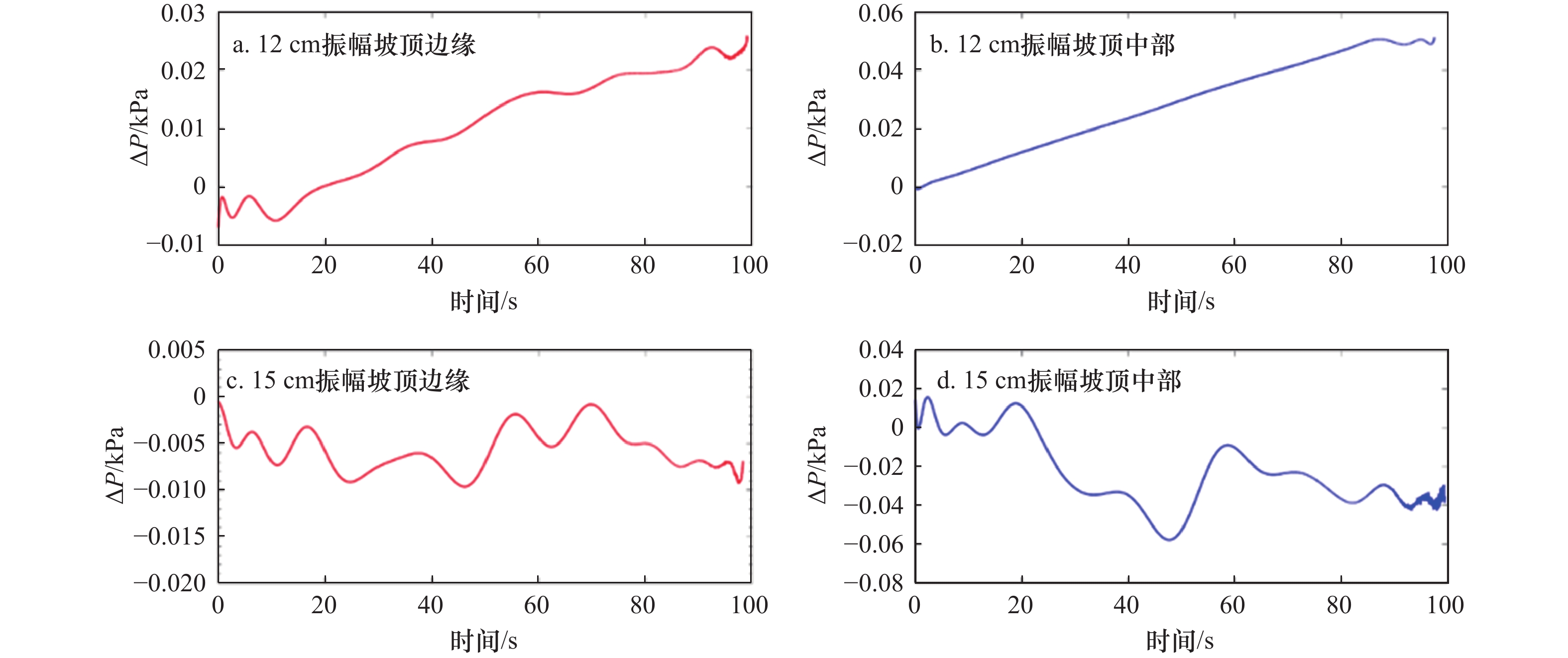Experimental study on the dynamic process and characteristics of slope sediments after breaking of internal solitary waves
-
摘要: 为完善内孤立波与海底斜坡沉积物相互作用研究,本文着眼于内孤立波破碎后在斜坡上继续运动的阶段,开展物理模拟实验,分析斜坡响应的土压力和超孔隙水压力的变化状况,揭示内波作用过程。研究发现:斜坡沉积物颗粒在内孤立波破碎引起的涡旋和渗流的共同作用下,会发生再悬浮,斜坡坡度变化不改变沉积物产生动力响应的主导动力作用;内孤立波振幅大小影响涡旋与渗流两者的比例,即在小振幅条件下由涡旋作用主导,在大振幅条件下由渗流作用主导;破碎流体在沿斜坡冲出坡顶位置后形成新的涡流,沉积物在新生涡流作用下的动力响应受斜坡坡度的影响。本文结果对于研究内孤立波再悬浮运移海底沉积物、改造海底地形地貌具有参考价值。Abstract: In order to improve the study of the interaction between internal solitary waves and submarine slope sediments, the stage of continued motion on the slope after internal solitary waves fragmentation is focused on in this paper, and conducts physical simulation experiments to analyse the changes in earth pressure and super-pore water pressure in response to the slope to reveal the process of internal wave action. The results show that the sediment particles on the slope are resuspended under the combined action of vortex and seepage caused by the internal solitary waves fragmentation, and the change in slope gradient does not change the dominant dynamic role of the sediment in generating the dynamic response; the amplitude of the internal solitary waves affect the ratio between vortex and seepage, i.e. the vortex is dominant under small amplitude conditions and the seepage is dominant under large amplitude conditions; the fragmented fluid forms a new dynamic role when it rushes out along the slope. The dynamic response of the sediment to the new vorticity is influenced by the slope of the slope. The results of this paper are useful for the study of internal solitary waves resuspension transporting seafloor sediments and modifying seafloor topography.
-
Key words:
- internal solitary wave /
- velocity /
- submarine slope /
- dynamic response
-
表 1 实验工况
Tab. 1 Test conditions
实验
组次上层流体密
度/(kg·m−3)下层流体密
度/(kg·m−3)振幅/
cm斜坡角
度α/(°)坡体长度L/
cm实验1 998 1 020 12 3 622 实验2 998 1 028 15 3 622 实验3 998 1 020 12 9 239 实验4 998 1 028 15 9 239 -
[1] Chen Chenyuan, Hsu J R C, Chen H H, et al. Laboratory observations on internal solitary wave evolution on steep and inverse uniform slopes[J]. Ocean Engineering, 2007, 34(1): 157−170. doi: 10.1016/j.oceaneng.2005.11.019 [2] Helfrich K R. Internal solitary wave breaking and run-up on a uniform slope[J]. Journal of Fluid Mechanics, 1992, 243: 133−154. doi: 10.1017/S0022112092002660 [3] Wang B J, Bogucki D J, Redekopp L G. Internal solitary waves in a structured thermocline with implications for resuspension and the formation of thin particle-laden layers[J]. Journal of Geophysical Research: Oceans, 2001, 106(C5): 9565−9585. doi: 10.1029/2000JC900101 [4] Ribbe J, Holloway P E. A model of suspended sediment transport by internal tides[J]. Continental Shelf Research, 2001, 21(4): 395−422. doi: 10.1016/S0278-4343(00)00081-9 [5] 田壮才, 郭秀军, 乔路正, 等. 南海北部海底沉积物临界起动流速空间分布特征分析[J]. 岩石力学与工程学报, 2016, 35(S2): 4287−4294. doi: 10.13722/j.cnki.jrme.2016.0800Tian Zhuangcai, Guo Xiujun, Qiao Luzheng, et al. Analysis of spatial distribution characteristics of seabed sediments critical starting velocity in the northern South China Sea[J]. Chinese Journal of Rock Mechanics and Engineering, 2016, 35(S2): 4287−4294. doi: 10.13722/j.cnki.jrme.2016.0800 [6] Nakayama K, Shintani T, Kokubo K, et al. Residual currents over a uniform slope due to breaking of internal waves in a two-layer system[J]. Journal of Geophysical Research: Oceans, 2012, 117(C10): C10002. [7] Smith J M, Larson M, Kraus N C. Longshore current on a barred beach: field measurements and calculation[J]. Journal of Geophysical Research: Oceans, 1993, 98(C12): 22717−22731. doi: 10.1029/93JC02116 [8] Thorpe S A. The generation of alongslope currents by breaking internal waves[J]. Journal of Physical Oceanography, 1999, 29(1): 29−38. doi: 10.1175/1520-0485(1999)029<0029:TGOACB>2.0.CO;2 [9] Southard J B, Cacchione D A. Experiments on bottom sediment movement by breaking internal waves[M]//Swift D J P, Duane B B, Pilkey O H. Pilkey Shelf Sediment Transport: Process and Pattern. Stroudsburg, PN: Dowden, Hutchinson and Ross, 1972. [10] Jia Yonggang, Tian Zhuangcai, Shi Xuefa, et al. Deep-sea sediment resuspension by internal solitary waves in the northern South China Sea[J]. Scientific Reports, 2019, 9(1): 12137. doi: 10.1038/s41598-019-47886-y [11] 乔路正, 郭秀军, 田壮才, 等. 内孤立波浅化破碎过程斜坡沉积物孔压响应特征实验分析[J]. 海洋学报, 2018, 40(1): 68−76.Qiao Luzheng, Guo Xiujun, Tian Zhuangcai, et al. Experimental analysis of pore pressure characteristics of slope sediments by shoaling internal solitary waves[J]. Haiyang Xuebao, 2018, 40(1): 68−76. [12] 方欣华, 杜涛. 海洋内波基础和中国海内波[M]. 青岛: 中国海洋大学出版社, 2005.Fang Xinhua, Du Tao. Fundamentals of Oceanic Internal Waves and Internal Waves in the China Seas[M]. Qingdao: China Ocean University Press, 2005. [13] 杜辉, 魏岗, 张原铭, 等. 内孤立波沿缓坡地形传播特性的实验研究[J]. 物理学报, 2013, 62(6): 064704. doi: 10.7498/aps.62.064704Du Hui, Wei Gang, Zhang Yuanming, et al. Experimental investigations on the propagation characteristics of internal solitary waves over a gentle slope[J]. Acta Physica Sinica, 2013, 62(6): 064704. doi: 10.7498/aps.62.064704 [14] 胡瑞庚, 刘红军, 时伟. 驻波作用下粉土海床累积液化机制分析[J]. 岩土工程学报, 2021, 43(7): 1228−1237.Hu Ruigeng, Liu Hongjun, Shi Wei. Mechanism of residual liquefaction of silty seabed under standing waves[J]. Chinese Journal of Geotechnical Engineering, 2021, 43(7): 1228−1237. [15] Diamessis P J, Jacobs G B. Near-Bottom Turbulence and Sediment Resuspension Induced by Nonlinear Internal Waves[R]. Ithaca: Cornell University, 2015. -





 下载:
下载:











